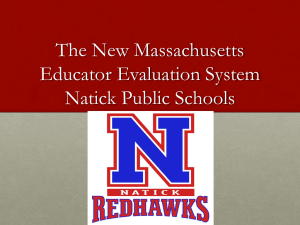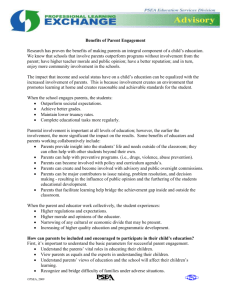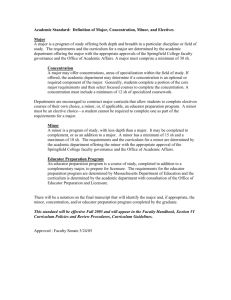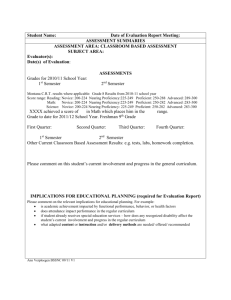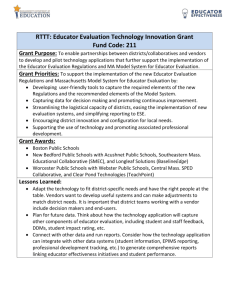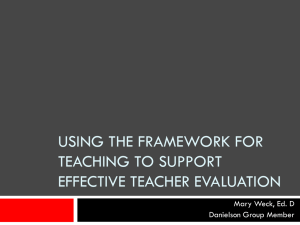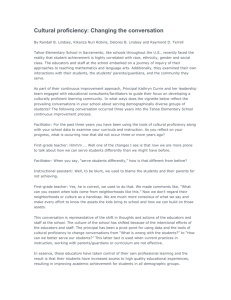In-Service Professional Development
advertisement
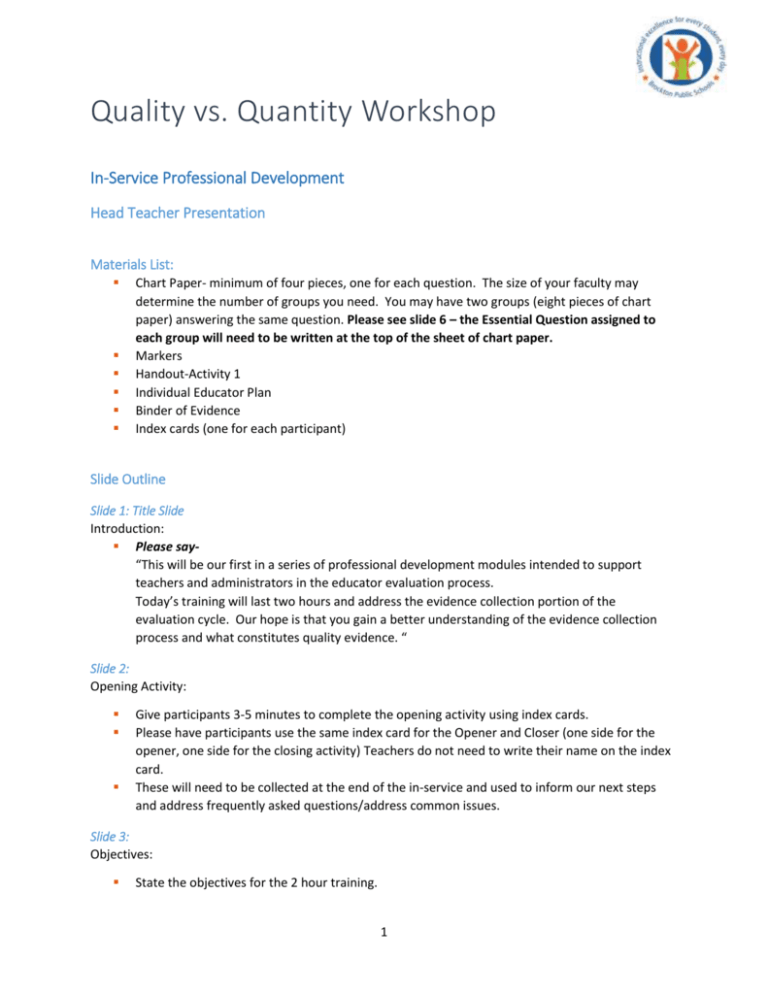
Quality vs. Quantity Workshop In-Service Professional Development Head Teacher Presentation Materials List: Chart Paper- minimum of four pieces, one for each question. The size of your faculty may determine the number of groups you need. You may have two groups (eight pieces of chart paper) answering the same question. Please see slide 6 – the Essential Question assigned to each group will need to be written at the top of the sheet of chart paper. Markers Handout-Activity 1 Individual Educator Plan Binder of Evidence Index cards (one for each participant) Slide Outline Slide 1: Title Slide Introduction: Please say“This will be our first in a series of professional development modules intended to support teachers and administrators in the educator evaluation process. Today’s training will last two hours and address the evidence collection portion of the evaluation cycle. Our hope is that you gain a better understanding of the evidence collection process and what constitutes quality evidence. “ Slide 2: Opening Activity: Give participants 3-5 minutes to complete the opening activity using index cards. Please have participants use the same index card for the Opener and Closer (one side for the opener, one side for the closing activity) Teachers do not need to write their name on the index card. These will need to be collected at the end of the in-service and used to inform our next steps and address frequently asked questions/address common issues. Slide 3: Objectives: State the objectives for the 2 hour training. 1 Slide 4: Agenda: Please inform teachers the training is due to last two hours. The first hour will take them through Tips for Evidence Collection. The second hour teachers will do some work on their own to apply what was learned to their own educator plans and evidence gathered last year. Slide 5: Share the analogy on slide 5. Before moving onto slide 6 please ask teachers to count off by 4s or 8s. The number of groups you need will be determined the size of your faculty. Please try to ensure your groups are mixed not grade level specific. You may, however, wish to separate your faculty into caseload and classroom teacher groups to ensure the activity is meaningful to both groups of educators. This will give you the groupings you will need to begin the activity on slide 6. Slide 6: Introduce the four essential questions which will be the focus for the activity in session I. Note: If you have a group(s) of Caseload Educators, the Essential Questions are the same. Slide 7: Go over the instructions to the activity prior to having teachers move into their groups. Each group will need the piece of chart paper with their essential question written at the top (prepared in advance) and a colored marker. Each group should choose a recorder and someone to share out at the end of the activity. Pose the following to your teachers as a way of illustrating what you are asking them to do. Please say“Your evaluator is asking you these four essential questions. What evidence or artifacts can you provide that will demonstrate your proficiency as an educator?” Teachers may want to think about evidence they gathered last year. Please have teachers move into their groups and complete the activity on slide 8. Allow 10-15 minutes for people to brainstorm a list of potential sources of evidence that would demonstrate proficiency. You may proceed to slide 9 once teachers are in their groups and their task is clear. Slide 8: Repeat of slide 7. Leave this slide up as people are working in their groups. Give group members at two minute warning before bringing them back together. Ask the recorder of each group to bring the chart paper to the front of the presentation space so that all participants can see each list. Note: If you have Caseload educators working separately, ask them to note that when they report out. 2 Slide 9: Please remind participants: “Your evaluator is asking you these four essential questions. What evidence or artifacts can you provide that will demonstrate your proficiency as an educator.” Have each group report out the different types of evidence that they came up with. After all groups have shared their lists ask the first of two questions on Slide 9. Please say“What pieces of evidence do you see on more than one list? Circle those pieces of evidence that appear on more than one list. Ask the second question, is there anything missing that should be included?” Record those responses on the appropriate list. Point out to the group the circled items. Share that these items represent high quality pieces of evidence that can be used to demonstrate proficiency on more than one standard. Slide 10: Ask the group to take a look at the list generated for question 1. Share slide 11 pointing out that the essential question serves as a summary for Standard 1: Curriculum Planning and Assessment. The evidence identified on the list for question one addresses the indicators and elements stated in the rubric under standard 1. PLEASE NOTE: the message should not be that a teacher needs to provide all of these pieces of evidence in order to be proficient, but rather determine which pieces best illustrate their level of proficiency. This is not an all-inclusive list. It is merely the most common sources of evidence identified by teachers. Slide 11: Ask the group to take a look at the list generated for question 2. Share slide 12 pointing out that the essential question serves as a summary for Standard 2: Teaching All Students. The evidence identified on the list for question one addresses the indicators and elements stated in the rubric under standard 2. PLEASE NOTE: the message should not be that a teacher needs to provide all of these pieces of evidence in order to be proficient, but rather determine which pieces best illustrate their level of proficiency. This is not an all-inclusive list. It is merely the most common sources of evidence identified by teachers. Slide 12: Ask the group to take a look at the list generated for question 3. Share slide 13 pointing out that the essential question serves as a summary for Standard 3: Family and Community Engagement. The evidence identified on the list for question one addresses the indicators and elements stated in the rubric under standard 3. PLEASE NOTE: the message should not be that a teacher needs to provide all of these pieces of evidence in order to be proficient but rather determine which pieces best illustrate their level of proficiency. This is not an all-inclusive list. It is merely the most common sources of evidence identified by teachers. 3 Slide 13: Ask the group to take a look at the list generated for question 4. Share slide 14 pointing out that the essential question serves as a summary for Standard 4: Professional Culture. The evidence identified on the list for question one addresses the indicators and elements stated in the rubric under standard 4. PLEASE NOTE: the message should not be that a teacher needs to provide all of these pieces of evidence in order to be proficient, but rather determine which pieces best illustrate their level of proficiency. This is not an all-inclusive list. It is merely the most common sources of evidence identified by teachers. Slide 14-19: These slides serve as a summary of the previous activity. These tips should be shared individually. Please read each slide and emphasize the idea of Quality vs. Quantity. In slide 15, please emphasize that a teacher does not need to make multiple copies of a piece of evidence they are using to address more than one standard. In slide 18, please emphasize that this statement “…once sufficient evidence has been identified and/or collected to demonstrate proficiency on one or more standards, there is no need to add more…” does not imply that if an educator is rated Proficient on a standard or standards at the formative evaluation, he or she is finished collecting evidence for the remainder of the cycle. The statement is meant to highlight the fact that evidence collection is not about quantity, but rather quality. The evaluation process is about points in time. Educators continue to demonstrate how they are continuing to grow and develop from the formative to the summative evaluations. In slide 19 please emphasize that there are no specific requirements as to how evidence must be organized or shared with the evaluator. Slide 20: Ten Minute Break (Please adhere to the ten minute break time allotted, so that you able to get through session 2.) Slide 21: Review the agenda for session 2. Distribute “Three Types of Evidence” handout. Ask teachers to read the front side of the handout as an introduction to session 2 (5 minutes) Keep slide 21 up on the screen while people are reading. Slide 22: Review the three types of evidence outlined on the slide. Ask teachers to turn to the back of the handout for a description of each category and read independently. (3 minutes) Summarize the key components of each category: Products of practice: emphasize “naturally occurring products of your day-to-day work.” Multiple Measures of Student Learning, Growth and Achievement: Focus question: how are you able to demonstrate your students’ growth/progress beyond traditional standardized assessments? Remind educators to think about the many ways students demonstrate their growth/progress through informal assessments as well. 4 Other evidence related to Standards of Practice: Your job encompasses more than just time in front of the students in the classroom. Make sure you showcase the “behind the scenes” work that you do. Do you invite families of your students to a school event such as Open House/Parent Conferences? Do you send home a newsletter to inform families of what’s happening in your classroom? Do you serve on committees or community groups connected to the school community? Ask teachers to take out their own educator plans and evidence binders. Looking at their own goals and evidence they submitted last year to evaluators, ask them to take 10 minutes and answer the guiding questions on the activity sheet. Guiding Questions: What quality evidence can you gather this year that tells a story of what you do both in and out of the classroom? Given the lists generated in session I, what are a few pieces of quality evidence that weave a common thread through the four Standards? What evidence that you gathered last year would you consider high quality pieces of evidence? Remember evidence should be a combination of all three categories identified on slide 22. Note: if you have first year teachers in your building who do not have evidence from last year, please ask them to work with their mentor teacher or a grade level/subject area colleague. Slides 23-27: Please say“These slides serve as a wrap up of the training and the material covered today.” Slide 28: Please have teachers complete the closing activity and collect all index cards as they leave the meeting. Please say“Thank you very much for your participation today. We hope you have found this training helpful. Evidence collection is an ongoing process. You may have questions now and I am happy to try to answer them for you. If there are questions after you leave today, please feel free to contact me. If I am unable to answer them for you, I will make every effort to get back to you with the answer.” If there are questions you as the Head Teacher are unable to answer, please feel free to refer your teachers to the Educator Evaluation Specialists, Michele Conners or Carrie Copp, who can be reached at BEGEN @bpsma.org. Slides 29-32 These slides were not part of the original presentation. They were created to provide some follow up/clarification when needed. They have been added here as an additional resource/visual. 5
